
A megalith is a large stone that has been used to construct a prehistoric structure or monument, either alone or together with other stones. There are over 35,000 in Europe alone, located widely from Sweden to the Mediterranean sea.

Reguengos de Monsaraz is a municipality in Évora District in Portugal. The population in 2011 was 10,828, in an area of 464.00 km2. The City of Reguengos de Monsaraz proper has a population of 7,308.
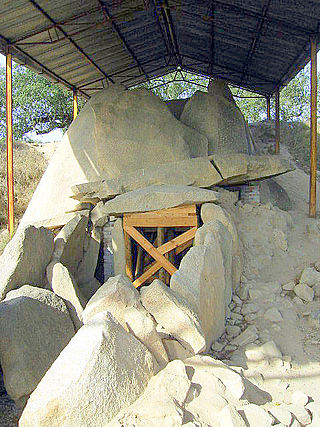
Great Dolmen of Zambujeiro is a megalithic monument located in Nossa Senhora da Tourega, near Valverde, in the municipality of Évora, considered one of the biggest such structures in the Iberian Peninsula.

Monsaraz is a civil parish (freguesia) of the municipality of Reguengos de Monsaraz, on the right margin of the Guadiana River in the Portuguese Alentejo region, near its border with Spain. The population in 2011 was 782, in an area of 88.29 km2.

The Prehistoric Rock-Art Site of Escoural Cave is a structure known for its Paleolithic-era rock-art and funerary burial site, located in the Portuguese municipality of Montemor-o-Novo, in the civil parish of Santiago do Escoural.

Évora is a city and a municipality in Portugal. It has 53,591 inhabitants (2021), in an area of 1,307.08 square kilometers (504.67 sq mi). It is the historic capital of the Alentejo and serves as the seat of the Évora District.
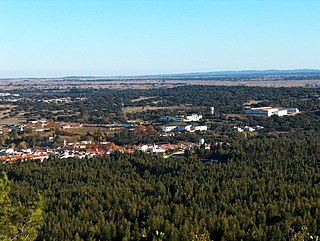
Nossa Senhora da Tourega is a former civil parish in the municipality of Évora, Portugal. In 2013, the parish merged into the new parish Nossa Senhora da Tourega e Nossa Senhora de Guadalupe. The population in 2011 was 686, in an area of 196.19 km².
Nossa Senhora do Bispo is a former civil parish in the municipality of Montemor-o-Novo, Portugal. In 2013, the parish merged into the new parish Nossa Senhora da Vila, Nossa Senhora do Bispo e Silveiras. It has an area of 121.83 km², and a population of approximately 5411 inhabitants in 2001. It contains the localities Fazendas do Cortiço, Ferro da Agulha and São Geraldo.
Castle of Cola is an Iron Age residence and Islamic redoubt in the Portuguese Alentejo, classified as a National Monument. The castro is part of a larger archaeological park of Castro da Cola, that includes various Megalithic and Calcolithic monuments, including necropolises of the Bronze and Iron Ages. The Castro-era polygonal plan, included reinforced blocks, with an entrance controlled by tower. The remaining defensive structure was circled by walls, with still exist, on the neighboring pasture-lands protecting the castle.
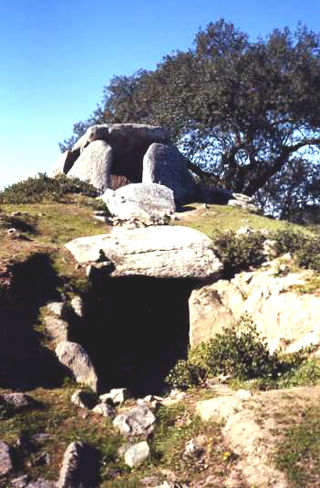
The Great Dolmen of Comenda da Igreja is a megalithic funerary site in the civil parish of Nossa Senhora do Bispo, in the municipality of Montemor-o-Novo, in the central Alentejo region of continental Portugal.

Torrão is a civil parish and town, in the municipality of Alcácer do Sal, in the Portuguese district of Setúbal, bordering on the districts of Évora and the Beja. It is crossed by the river Xarrama River. The population in 2011 was 2,295, in an area of 372.39 km2.
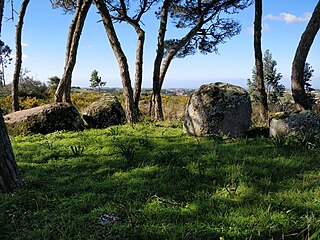
The Barreira Megalithic Complex is located in the Sintra municipality in the Lisbon District of Portugal. Situated on a small wooded hill overlooking the village of Odrinhas, site of Roman ruins and an archaeological museum, it consists of about twenty menhirs and other monoliths or megaliths.
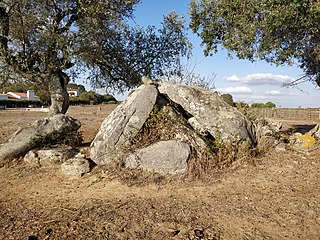
The Antas da Valeira are two Chalcolithic dolmen, or burial chambers, about 100 metres apart, close to the village of Nossa Senhora da Graça do Divor in the Évora district of the Alentejo region of Portugal. Situated in a farm field about one kilometer from the Vale Maria do Meio Cromlech and ten kilometers from the notable megalithic complex of the Almendres Cromlech, these dolmen are among numerous megalithic sites identified in the Évora area. These two monuments have yet to be studied by archaeologists and are in a poor condition.

The Vale Maria do Meio Cromlech is a megalithic stone circle situated in Évora district in the Alentejo region of Portugal. It is believed to date back to the fifth millennium BCE or earlier, and is classified as a National Monument.

The Xerez Cromlech, also known as the Xarez Cromlech, is a megalithic complex that is believed to date back to the 4th or 5th millennia BCE. It is situated near the town of Monsaraz in the Évora district of the Alentejo region of Portugal, close to the Spanish border. The present site of the cromlech is not its original location. Due to the construction of the Alqueva Dam for hydroelectric purposes, which led to the flooding of the original site from 2002, it was transferred from an area that is now under water to its present site close to the Orada Convent. This was the only monument to be moved, with the dam leading to the disappearance of prehistoric engravings and the Roman Castelo da Lousa.
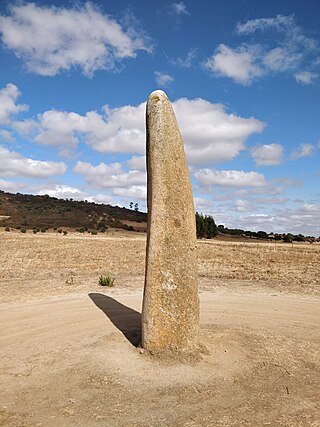
The Menhir of Outeiro, also known as the Penedo Comprido is a megalith located midway between the villages of Outeiro and Barrada near the municipality of Reguengos de Monsaraz, in the district of Évora, in the Alentejo region of Portugal. It is a few kilometers from the Portuguese-Spanish-border. The stone was discovered on its side in 1969 by Henrique Leonor Pina and José Pires Gonçalves and, on the initiative of Gonçalves, it was raised again around 1970. The menhir was classified as a Portuguese National Monument in 1971.

The Menhir of Bulhoa, also known as the Menhir of Abelhoa, is a granite megalithic standing stone, located near the parish of Monsaraz, in the municipality of the Reguengos de Monsaraz, in the Évora district of the Alentejo region of Portugal. It was classified as a National Monument by the Government of Portugal in 1971.

The Antas do Barrocal, also known as the Antas Herdade do Barrocal, are a set Neolithic dolmens, or megalithic funeral chambers, at Monte do Barrocal, in the parish of Nossa Senhora da Tourega, in the Évora District of the Alentejo region of Portugal. They are in an area with a high concentration of megalithic sites. Nine have been identified but only two are more than remnants and only Number 1 can be visited. This has been classified as a National Monument since 1910.




























